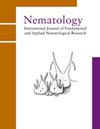不同白蛴螬寄主对昆虫病原线虫敏感性的机制
IF 1.2
4区 生物学
Q2 ZOOLOGY
引用次数: 0
摘要
白蛴螬是金龟甲虫的散发性根食幼虫,由于其隐蔽性和对化学杀虫剂的抗性,控制起来很困难。利用昆虫病原线虫(EPN)进行此类控制是有潜力的。然而,EPN对白蛴螬的成功感染受到白蛴螬先天易感性降低的限制,其表现形式为行为、形态和生理防御。本研究旨在探讨蛴螬对EPN的不同生理防御机制。研究了以往对EPN易感程度较低的白蛴螬Pegylis sommeri和Schizonycha affinis,以及以往对EPN易感程度较高的Maladera sp. 4。测定了EPN穿透蛴螬和EPN共生细菌在昆虫血淋巴内生长的能力、包封率以及线虫在昆虫血淋巴内的生长情况。结果表明,EPN和蛴螬对线虫的渗透能力、囊化率和在血淋巴中的生长均存在差异。不同种类的EPN共生细菌能够在所有测试的白蛴螬种的血淋巴中生长。结果表明,所调查的白蛴螬倾向于抵抗大部分EPN的初始渗透,从而避免感染。本文章由计算机程序翻译,如有差异,请以英文原文为准。
Mechanisms behind differential white grub host susceptibility to entomopathogenic nematodes
Control of white grubs, the sporadic root-feeding larvae of scarabid beetles, is difficult due to their cryptic nature and resistance to chemical insecticides. Potential exists for the use of entomopathogenic nematodes (EPN) for such control. The successful infection of white grubs by EPN, however, is limited by the white grubs’ innate reduced susceptibility in form of behavioural, morphological and physiological defences. This study aimed to determine the different physiological defence mechanisms of white grubs against attack by EPN. The white grub species, Pegylis sommeri and Schizonycha affinis, which were previously found to have a low level of susceptibility to EPN, and Maladera sp. 4, which had previously shown a relative high level of susceptibility, were examined. The ability of the EPN to penetrate the white grubs and of the EPN symbiotic bacteria to grow inside the insect haemolymph, the encapsulation rates, as well as the nematode growth inside the insect haemolymph, were determined. The results showed that the ability of the nematodes to penetrate white grubs, the encapsulation rates and growth in the haemolymph varied between EPN and white grub species. The different species of the EPN symbiotic bacteria were able to grow in the haemolymph of all the white grub species tested. The results indicate that the white grub species investigated tended to resist the initial penetration of most of the EPN studied, thus avoiding infection.
求助全文
通过发布文献求助,成功后即可免费获取论文全文。
去求助
来源期刊

Nematology
生物-动物学
CiteScore
2.60
自引率
33.30%
发文量
67
审稿时长
3 months
期刊介绍:
Nematology is an international journal for the publication of all aspects of nematological research (with the exception of vertebrate parasitology), from molecular biology to field studies. Papers on nematode parasites of arthropods, and on soil free-living nematodes, and on interactions of these and other organisms, are particularly welcome. Research on fresh water and marine nematodes is also considered when the observations are of more general interest.
Nematology publishes full research papers, short communications, Forum articles (which permit an author to express a view on current or fundamental subjects), perspectives on nematology, and reviews of books and other media.
 求助内容:
求助内容: 应助结果提醒方式:
应助结果提醒方式:


